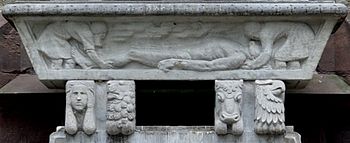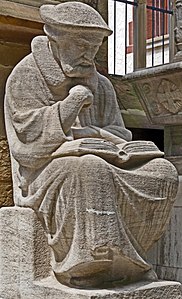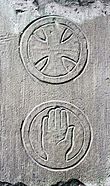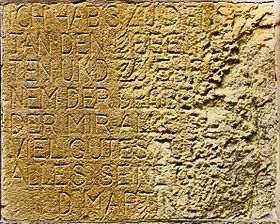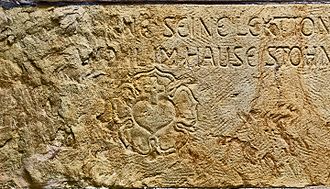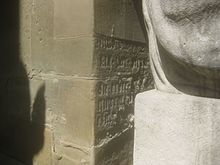Reformation Monument (Stuttgart)
The Württemberg Reformation Monument at the Hospital Church in Stuttgart is a monument that was created in 1917 on the occasion of the four hundredth anniversary of Luther's posting of the theses . The memorial was designed by the sculptor Jakob Brüllmann according to plans by Theodor Fischer and made from local Crailsheim shell limestone .
The victoriously resurrected Christ with the victory flag is enthroned in the center of the enclosed facility. It is surrounded by seated figures of the reformer Martin Luther and Johannes Brenz , the reformer of Württemberg, as well as reliefs with scenes from rural life and reliefs and inscriptions from the Reformation age .
The Stuttgart Reformation Monument , in dimensions and composition a reflection of the proverbial “Swabian modesty”, cannot compete in size with the “largest Reformation monument in the world”, the Luther Monument in Worms, but together with the Reformation Monument in Geneva it is considered to be significant New development of the monument concept, not least because, unlike all other monuments, it does not focus on Luther, but on the risen Christ.
construction

Site plan of the planned Reformation monument, drawing by Theodor Fischer , 1902.
|
The nave of the Hospital Church was destroyed in the Second World War except for the south and west facade. The monument is leaning against the remaining south facade of the nave. The west facade had to give way to a new administration building in the 1950s. For the same reason, the south facade towards the choir was shortened by two axes, so that only five wall fields remained. The four outer fields are broken through by windows, the middle field is occupied by the former south portal and a window above.
The memorial stands on a two-tier, low platform measuring 4.50 × 7.25 meters and is in front of the high window to the right of the former south portal. The risen and victorious Christ is enthroned in the bright light of the window behind it, which underlines the idea of resurrection. The monument is framed to the left and right by the two buttresses that flank the window. The seated figures of Johannes Brenz and Martin Luther lean against the pillars. The wall between the figure of Christ and the figures of the reformers is covered with inscriptions and reliefs. The pedestals of the reformers are connected with a low parapet wall, which limits the monument area to a wide central entrance, as was also the case with larger grave monuments of the time.
The Hospitalplatz was previously planted with an avenue (see map), of which only the row of chestnut trees on the south facade of the Hospital Church remained. In 2010, the builder of the New Hospitalhof, Arno Lederer , pleaded for the facade and the half-hidden Reformation monument to be exposed. The felled trees were to be replaced by a row of trees on the opposite side of the street. However, this proposal was rejected.
Christ with the victory flag
The figure of the victoriously resurrected Christ is enthroned on an approximately 3 meter high substructure, which, like the figures of the reformers, ends with the cornice of the two flanking buttresses. At about 2.30 meters, the figure of Christ is slightly higher than the reformer figures with a height of 1.90 meters.
One leg of the half-kneeling figure is bent at right angles as if in a sitting position, while the other knee touches the floor. The resulting apparent walking motion indicates that Christ has only just emerged from the grave. The body-length, waving robe is laid in strict, sweeping folds that support the "impression of floating up".
In his right hand Christ holds the standard of victory , the sign of his victory over death. The richly turned flagpole bears a rigid transverse banner of narrow, elongated shape that ends in a two-lobed dovetail. Christ holds the flag, which takes up almost the width of the church window behind, behind his head so that his face is not covered. The standard shows the lamb carrying the cross as a symbol of Christ's death on the cross, the chalice with a floating host, two rosettes , two five-pointed stars and other, unexplained ornaments .
Substructure
The substructure of the central figure of Christ consists of an inscription panel, symbolic figures of the four evangelists and the sarcophagus on which Christ is enthroned.
The inscription panel bears a saying from Jesus:
- "I am the way, the truth and the life, no one comes to the Father but through me." ( John 14: 5)
The sarcophagus rests on block-like stylized symbolic figures of the four evangelists (foot blocks), on the left man and lion for Matthew and Mark, on the right the bull and eagle for Luke and John.
The "black hole" between the two blocks with the evangelist figures can be seen as a symbol of the grave from which Christ rose: "The deep, shadowy cavity under the sarcophagus is essential for making the Christ figure appear" rising "."
Sarcophagus reliefs
|
|
On the front of the sarcophagus the burial of the naked body of Christ is depicted by Joseph of Arimathea and Nicodemus .
The two side reliefs of the sarcophagus are dominated by a large round medallion with a paw cross as a symbol of Christ's death on the cross, from which a halo emanates as a symbol of his resurrection. The corners of the reliefs are decorated with small round medallions with Christian symbols. |
|
|
Corner medallions (from top left to bottom right).
|
|
|
Corner medallions (from top left to bottom right).
|
Luther and Brenz
The two reformers, the Württemberg reformer Johannes Brenz and the German reformer Martin Luther , sit at Christ's feet. The figures end at the level of the cornice of the two flanking buttresses, which at the same time forms the foot line of the figure of Christ. The statues, which are around 1.90 meters high, are shown in a sitting position. The backless seat is connected to a cuboid base about 1.10 meters high, which is in front of the buttresses . Including the base, the figures reach a height of about 3 meters.
"As historical figures, they differ from the visionary Christ through the full round sculpture and the portrait-like design ...". Both figures wear foot-length gowns and have an open Bible on their knees in front of them. The bareheaded, beardless Luther looks up with a distant gaze, and his right hand “opens up as if to grasp a revelation, to hold it, ready to write and detached from clenched rings”. The bearded Brenz wears a beret (the so-called "Brenzhütle"). He looks inwardly and humbly at the Bible before him; and while his left arm rests on the Bible, his right hand points back to himself.
“One difficulty lay in the parallelization of Luther and Brenz in view of the outstanding intellectual and historical importance of Luther. The artist has formally overcome it through the well thought-out contrapostal of the two figures, to which their spiritual expression corresponds. ... Brenz, in serious pensive reflection, is the one who "ponders" the thoughts of Luther as well as the holy scriptures, measures things by their standards and arranges the church according to them, Luther is the original fire spirit, the one with the greatest tension of the inner ear new outlook arises which the mouth has plunged into proclaiming. "
Parapet wall
The two front sides of the parapet walls have reliefs with rural representations. The left relief shows a woman with a sheaf of corn in her arm. She is talking to a mother who is out with her two children. Next to it you can see a planting woman and a sower. The right relief shows a man and a woman plowing with an ox.
On the left side of the parapet wall bears the inscription:
- "Inaugurated in the presence of King Wilhelm II and Queen Charlotte on June 24, 1917."
and right:
- "To commemorate the centenary of the Reformation in 1917."
Wall reliefs and inscriptions
In the wall fields between the pedestal of the figure of Christ and the figures of the reformers there are reliefs that depict scenes from the lives of the two reformers and show various inscriptions. The reliefs were made by the sculptor Eberhard Pfleiderer according to Jakob Brüllmann's designs. Some of them are weathered and some were destroyed in the Second World War.
| 1. | The old castle and the collegiate church symbolize the secular and spiritual starting point of the Reformation in Stuttgart. The old castle was the rulership of Duke Ulrich and Duke Christoph , who introduced the Reformation in Württemberg. The collegiate church was the spiritual place of the Reformation. |
| 2. | The relief shows Duke Christoph's coat of arms with a hunting horn and griffin as a helmet ornament . After Duke Ulrich introduced the Reformation in Württemberg in 1534, his son Duke Christoph pushed ahead with the consolidation of the Württemberg regional church, in particular through the enactment of the Great Württemberg Church Ordinance of 1559, in which Johannes Brenz played a major role.
For comparison: see coat of arms from Duke Ulrich's time at the old chancellery in Stuttgart . |
| 3. | The relief shows the distribution of the Lord's Supper to the believers. The Lord's Supper and Baptism are the two sacraments of Protestantism. |
| 4th | Inscription based on a saying by Johannes Brenz: "Love and Peace is the right slogan for Christians, because for the sake of the cause, Christ their captain is called a Prince of Peace." |
| 5-6. | Above: Round medallion with a paw cross . Below: Round medallion with the symbol of a blessing hand. |
| 7th | Inscription not deciphered: "... E ... / .. ABLA [SS]". |
| 11. | The relief shows Luther and the farmhand leader Georg von Frundsberg at the Reichstag in Worms . There he is said to have said to Martin Luther: "Little monks, little monks, you are walking a difficult course!" |
| 12. | Inscription based on a quote from Martin Luther: “I did it to serve the dear Christians and in honor of one who sits above. Who does me a lot of good every hour. It's all his grace. " |
| 13. |
Luther Rose (Luther's seal) and inscription of a saying of Martin Luther: "Every learning his lesson / so it is probably in the house Stohn". For comparison: see Luther rose . |
| 14th | Detail from the painting Luther's Sermon based on the predella of the Reformation altar by Lucas Cranach in the town church in Wittenberg .
For comparison: see Luther's sermon in Wittenberg . |
| 15th | Imperial eagle , left and right below a small coat of arms. |
| 16. | Inscription with the names of three reformers: " Melanchthon / Oekolampad / Speratus ". |
| 17th | Inscription not deciphered: "... 1521 ..." (the Reichstag took place in Worms in 1521 ). |
Two other, not preserved, reliefs showed a scene to the left of the Christ statue in which Johannes Brenz first met Martin Luther at the Heidelberg disputation in 1518, and to the right a picture of the Wartburg.
history
idea
Since 1884, Luther celebrations have been held annually in the Stuttgart Liederhalle , with a Luther bust of Adolf von Donndorf at the center . At such a celebration in 1903 the erection of a Luther statue in Stuttgart was suggested, which should be completed in 1917 for the four hundredth anniversary of the Reformation.
Principles
"For the Stuttgart Reformation monument, Theodor Fischer has now succeeded in picking up a completely new melody - new in relation to all existing Luther monuments." The Munich architect Theodor Fischer, who taught at the Technical University in Stuttgart from 1901 to 1908 , struck it in 1903 Hospitalplatz as the installation site of the monument because the Protestant Reformation in Stuttgart had started there. Fischer succeeded Adolf von Hildebrand , one of the leading sculptors of the time, who in his theoretical writing The Problem of Form in Fine Art postulated not to place monuments in a given place like foreign objects, but to select a suitable environment for them and put them on adapt the environment. “And indeed: The spatial extent of the not too large space at the Hospital Church, the intimate character that the old walls of the church with the green trees in front of it give it, make it appear as if it was made for a work that is emphatically closed organic Seeks connection with the environment in which it is to be placed. "
According to the ideas of Fischer, who was opposed to any stencil thinking, the monument should not become a pure Luther monument. “The idea that he put up for election for the monument [is] based on a completely new concept. He does not limit himself to the often repeated motif of a single free figure, he thinks of the cross of the Redeemer as the powerful center of the whole. ”Similar to the traditional crucifixion groups , Christ should be placed next to two people, but not the mother of Jesus and his disciple Johannes , but the two reformers Luther and Brenz. As a result, the memorial became a Reformation memorial, and with the addition of Johannes Brenz , the Württemberg reformer, it became the Württemberg Reformation memorial .
In contrast to the monuments that were common at the time, such as the Kaiser Wilhelm and Bismarck monuments, but above all the epoch-making Luther monument in Worms from 1868, the planned complex should not impress with its monumental dimensions, but rather correspond to modest Swabian dimensions.
competition
Designed by Hermann Lang , Munich.
Designed by Jakob Brüllmann , Stuttgart.
As early as 1906, the Munich sculptor Hermann Lang, known with Fischer, presented a draft for the planned monument. It took seven years for the original idea to become final and for a competition to be announced in January 1911. The announcement stated: "The aim is to portray Martin Luther, the German reformer and Johannes Brenz, the reformer of Württemberg, whose figures could be brought into an artistic context with the cross of Christ." However, the proposal should not be binding. Four of the 71 entries were shortlisted (see figures). One of them was the design by the Swiss sculptor Jakob Brüllmann , who had lived in Stuttgart since 1900 and was the winner of the competition with his design based on plans by Theodor Fischer . In his design he had replaced the crucified Christ with the risen Christ with the flag of victory. Possibly he was inspired by the Golden Christ, also a Christ with the victory flag, which the competitor Hermann Lang had created in 1903 for the Friedenskirche in Ludwigsburg.
inauguration
The memorial was inaugurated on June 24, 1917, Johannes Brenz's birthday, in the middle of the war and given to the entire Protestant parish of Stuttgart as property.
Second World War
During the Second World War, the Reformation Monument and the Hospital Church were badly damaged. Two wall reliefs were completely destroyed, others partially. The lost parts of the wall reliefs were not restored. The heavily damaged figure of Christ was renewed by the sculptor Emil Brüllmann (1902–1988), the artist's son, and handed over to the parish in 1962. For the 500th birthday of Brenz, the monument was cleaned and restored in 1999.
reception
We owe Johannes von Merz, later church president of the Evangelical Church in Württemberg , a fitting characterization of the basic ideas that guided Jakob Brüllmann when composing the monument. Merz's essay, from which the following extracts were taken, was written in 1917, the year the monument was erected:
- “The distinctive feature of Brüllmann's conception was and is its interdependence of the formal design and the content-related task, the conditions given by the architectural connection and the basic lines of the work that is independent of the architecture. The rising pillars of the finely dimensioned church wall and the niche that formed between them provided the decisive stimulus. In the clear space between the shadows of the pillars, the rising figure of the risen Christ was placed on a substructure that strongly emphasizes the horizontal, spreading out in relief in front of the church window and thus enabling the representation of the movement in stone. The upward movement of the pillars is transferred to the figure ...; in outline ... something of the movement is revealed which marks the dawn of a new epoch in intellectual history, the 'dawn of a new day for humanity'. The artist has given us an extraordinarily apt sensualization of the Reformation idea ... "
- “The large parts of the composition are always self-contained, and yet the artist knew how to wrap an invisible bond around them, which holds them tightly together and gives us the most lively relationship between them. The main masses are presented in a simple, strict outline, only the sarcophagus and the victory flag, which emphasize the horizontal, which is so important for the composition, show richer ornamentation. "
In his compendium of "Reformation monuments of the 19th and 20th centuries", Otto Kammer highlights the novelty of Jakob Brüllmann's main work:
- “The“ actual ”monument century can be narrowed down quite precisely between the anniversary years 1817 and 1917. With the Reformation monuments in Geneva and Worms, there are two more important accents at the end, which at the same time represent something new, after a few years earlier the great competition in Coburg had brought a kind of »army show« of the expiring era. "
- “Among the winners, the design by Georg Wrba from Dresden was particularly noteworthy , a larger than life seated Luther with an open Bible under a crucifixion scene, framed by life-size, semi-plastic statues of Hutten , Melanchthon and two electors. Wrba was possibly inspired with his design idea by Brüllmann's design for the Stuttgart monument, which had just become known at the time. "
literature
General
- Competition for the Württemberg Reformation Monument in Stuttgart In: German Bauzeitung Volume 45, 1911, page 24, online: .
- Hils measurements: As-built plan Hospitalhof Stuttgart . Stuttgart 2008, online: .
- Thomas Borgmann: Dispute over trees at the hospital courtyard. In: Stuttgart-Zeitung.de of 10 December 2010 online: .
- Chronicle of the capital and residence city of Stuttgart 1911. Stuttgart 1911, pages 195–196.
- Isabella Fehle (Ed.): Johannes Brenz 1499–1570. Preacher, reformer, politician; Exhibition in the Hällisch-Fränkisches Museum, Schwäbisch Hall, February 28 to May 24, 1999 and in the Württembergisches Landesmuseum, Stuttgart, June 11 to October 3, 1999. Schwäbisch Hall 1999, pages 17–20 (Reformation monument), 120-141 ( Brenz as provost in Stuttgart).
- K. Hoffmann: The Württemberg Reformation Monument at the Hospital Church in Stuttgart. In: Schwäbischer Merkur No. 289 of June 23, 1917, page 3.
- Ev. Parish office of the Hospital Church Stuttgart (ed.): Festschrift for the dedication of the rebuilt Hospital Church Stuttgart on February 21, 1960. Stuttgart [1960], page 8, 10.
- Otto Kammer: Reformation monuments of the 19th and 20th centuries, an inventory. Leipzig 2004, page 232, VIII.
- Georg Kepp: Luther in the work of the sculptor Jakob Brüllmann. In: Art and Church New Series, Volume 17, 1940, pages 8-10.
- (ks): "In powerful unity and beauty". 50 years of the Württemberg Reformation Monument at the Stuttgart Hospital Church. - Remembering the 400th anniversary. In: Stuttgarter Zeitung No. 252 of October 31, 1967, page 21.
- Inauguration of the württ. Reformation monument in Stuttgart. In: Schwäbischer Merkur No. 291 of June 25, 1917, pages 3–4.
- Johannes Merz ; Theodor Haering (contribution): The Württemberg Reformation Monument Jakob Brüllmann in Stuttgart. Stuttgart [1917] : online .
- Winfried Nerdinger : Theodor Fischer, architect and urban planner. Berlin 1988, page 200, number 73.
- (oss): Hospital district. Compromise in the dispute over trees. In: Stuttgarter Zeitung of 10 February 2011 Page 22, online: .
- Rudolf Pfleiderer: The Reformation Monument in Stuttgart. In: [Leipziger] Illustrirte Zeitung 149th Volume, 1917, No. 3878 of October 25, 1917, page 599.
- Paul Sauer : 500 years of the hospital church. Stuttgart 1993, page 72, picture 53.
- Reformation monument in Stuttgart. In: Schweizerische Bauzeitung , Volume 70, 1917, Page 74, doi: 10.5169 / seals-33817 .
- Gerda Strecker (editor); Helmut A. Müller (Ed.): 500 years of the Stuttgart Hospital Church. From the Dominican monastery to the church in the city. Stuttgart 1993, pages 44-45.
- Gustav Wais : The St. Leonhard Church and the Hospital Church in Stuttgart. A representation of the two Gothic churches with explanations of architectural and art history. Stuttgart 1956, page 77, image 110.
Christian art paper for church, school and home
The articles in the Christian Art Journal (in chronological order) trace the history of the Reformation monument in chronological order.
- Johannes Merz : Luther and the fine arts [address at the Stuttgart Luther evening in the Liederhalle on November 10, 1903]. The Stuttgart Reformation Monument [epilogue] , Volume 46, 1904, pages 13-20.
- August Pauly: Hermann Lang's Bildhauerkunst , Volume 48, 1906, April, Pages 97-102, additional images: 103-105 (including a draft for a Luther memorial in Stuttgart).
- Georg Kopp: From the Stuttgart Reformation Monument. With an illustration. , Volume 52, 1910, pages 270-271, Figure: 261.
- Wilhelm von Gemmingen : To the evangelical people of Württemberg , Volume 52, 1910, page 271 (appeal for donations for the Reformation monument).
- H. Weizsäcker: The Reformation Monument for Württemberg , Volume 53, 1911, pages 24-27.
- Competition for the Württ. Reformation Monument in Stuttgart , Volume 53, 1911, page 31.
- [David Koch]: The Reformation Monument in Stuttgart , Volume 53, 1911, Pages 225–227, additional images: 222, 223 (winner of the competition).
- [David Koch]: The Reformation Monument in Stuttgart , Volume 55, 1913, Pages 455–458.
- Johannes Merz : The Württemberg Reformation Monument , Volume 59, 1917, Pages 130-136.
- Theodor Haering : Reformatio aeterna - XVI. saeculi - hodierna (Before Brüllmann's Reformation Monument) , Volume 59, 1917, page 161 (poem).
- Wilhelm von Gemmingen : The Württemberg Reformation Monument. Speech by the chairman of the monument committee at the dedication ceremony on June 24, 1917 at the monument , Volume 59, 1917, pages 162–163.
- [David Koch]: Epilogue. After the erection of the monument , Volume 59, 1917, pages 163–169, illustration: after 160.
- Johannes Merz : The Protestant Church Building in Württemberg , Volume 61, 1919, Pages 322–338, here: 338, 356.
swell
- Julius Hartmann; Carl Jäger: Johann Brenz, based on printed and unprinted sources, Volume 1. Hamburg 1840, page 200, online:
- Adolf von Hildebrand : The problem of the form in the fine arts. Strasbourg 1893, online: .
Web links
- Clinic TV: The Reformation Monument in Stuttgart, youtube .
Footnotes
- ↑ See: Website of the city of Worms .
- ↑ #Kammer 2004 , page 13: “The“ real ”monument century can be narrowed down quite precisely between the anniversary years 1817 and 1917. With the Reformation monuments in Geneva and Stuttgart, there are two more important accents that also represent something new. "
- ↑ The position and floor plan of the monument do not reflect the state it was in in 1917.
- ↑ #Hospital Church 1960 , page 15.
- ↑ Measurement in the 2008 inventory plan .
- ↑ #Borgmann 2010 .
- ↑ #oss 2011 .
- ↑ Dimensions according to the outline in #Fehle 1999 , page 18.
- ↑ #Merz 1917.2 , page 5.
- ↑ The rose applies u. a. As a sign of forgiveness through Christ, the five-pointed star is a symbol of the wounds of Christ. It is not known whether the symbols are used here with this or any other meaning.
- ↑ #Merz 1917.2 , page 8.
- ↑ Dimensions according to the outline in #Fehle 1999 , page 18.
- ↑ #Merz 1917.2 , page 4.
- ↑ # Koch 1913 , page 458.
- ↑ According to a quote without a source in #Fehle 1999 , page 18, Brenz is said to have held a scroll in his right hand that was supposed to give the regional church law and order for centuries (Great Württemberg Church Order of 1559). However, this cannot be seen in any illustration.
- ↑ #Merz 1917.2 , page 4.
- ↑ #Merz 1917.2 , page 5.
- ^ Quotation by Johannes Brenz, partial print: #Hartmann 1840 .
- ↑ #Kammer 2004 , page 232.
- ↑ According to Martin Luther's letter from interpreting : "Likewise, I did not seek my honor inside, God knows that, sir, but did it to serve the dear Christians and in honor of one who sits above, who does me so much good every hour, that if I had interpreted a thousand times as much and diligently, I still would not have deserved an hour to live or to have a healthy eye: it is all of his grace and mercy… ”.
- ↑ Martin Luther: The Small Catechism .
- ↑ #Merz 1917.2 , page 5.
- ↑ #Merz 1904 , page 17, # Weizsäcker 191 , page 24.
- ↑ #Merz 1904 , page 18.
- ↑ # Gemmingen 1910 .
- ↑ See especially: #Hildebrand 1893 , pp. 98-101.
- ↑ # Weizsäcker 1911 , pp. 25-26.
- ↑ # 1911 competition .
- ↑ #Fehle 1999 , page 18.
- ↑ # Gemingen 1917 .
- ↑ #Kammer 2004 , page 232, #ks 1967 .
- ↑ #Merz 1917.2 , pages 3–4.
- ↑ #Merz 1917.2 , page 7.
- ↑ #Kammer 2004 , page 250.
- ↑ #Pfleiderer 1917 : "Since the Thorwaldsen - Dannecker era, Stuttgart has not gotten any significant monuments, including the conventional equestrian statue of Kaiser Wilhelm I von Ruemann - Thiersch ."
- ↑ A “separate monument type” among the monuments with ensembles of people ( #Kammer 2004 , page 17).
- ↑ Competition in Coburg: In 1912 a "competition for the competition for the Luther memorial at the Coburg Fortress " was advertised, which was to be set up for the 1917 anniversary year of the Reformation. 145 designs were submitted for the competition, see competition for the Luther Memorial , May 25, 1913 - a Sunday , "Coburger Zeitung" online via the "Bayerische Landesbibliothek" .
- ↑ #Kammer 2004 , page 13, 92-93.
Coordinates: 48 ° 46 ′ 38.8 " N , 9 ° 10 ′ 21.9" E





